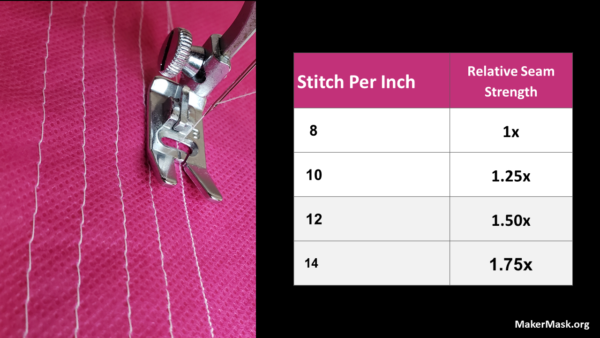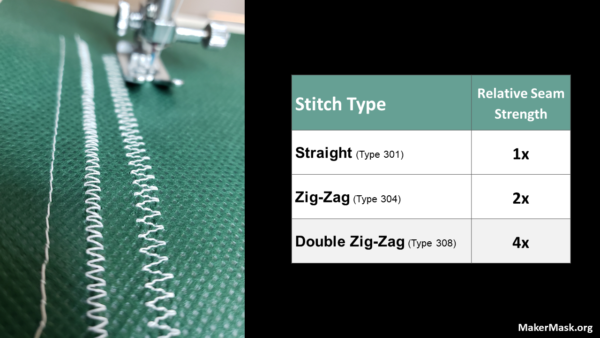Mask Math/Science Vignette: Mask Straps
According to the guidance released by the WHO in December mask straps should be designed to withstand at least 10 lbs of force ( 44.5 Newtons). The materials that most straps are constructed from (e.g., cotton straps and silicone bands) easily meet these requirements. However, we’ve seen a number of examples where the stitching that holds the head ties/straps to the mask rips out.
In this post we provide some simple techniques that can be used to improve seam strength, and then do a deeper dive into thread strength and the calculations used to determine whether or not your seams are strong enough to meet the WHO criteria.
Four Tips for Increasing Seam Strength
1. Use a Stronger Thread
Seam strength is proportional to thread strength, so increasing the strength of the thread you are using to sew your seams (e.g., using a heavier weight thread, or thread with stronger fibers) increases the seam strength. Most seams created using “All Purpose” 100% polyester thread satisfy WHO criteria. However, most created using “Fine” cotton/polyester thread do not.
2. Use a Stronger Seam
One of the easiest ways to increase the seam strength is to add more lines of stitching to your seam by changing the seam type. For example, a ‘box x’ seam is roughly 9 times stronger than a single stitch line. The figure below illustrates 6 simple seams that can be used for mask attachment loops and the effective increase in strength relative to a single stitch line.
3. Use More Stitches Per Inch
Another way to increase seam strength is to increase the stitches per inch that you are sewing by adjusting the stitch length on your sewing machine. The number of stitches per inch is usually set on the sewing machine and for general purposes is between 8 and 14 stitches per inch.
4. Use a Stronger Stitch Type
Although most mask designs use ‘straight’ stitches (type 301), seam strength can also be increased by increasing the number of stitches per inch by using other stitch patterns, such as a zig-zag stitch. The following table shows the effective increase in stitches per inch with different stitch types (Rotland et al, 2015). Increases in stitches per inch is proportional to seam strength.
Basic Seam Strength Calculations
How strong are my seams?
The number of stitches you pack into each inch AND the strength of the thread that you are using are important in determining seam strength. Seam strength is calculated as:
Seam Strength = (Loop Strength Ratio) x (Stitches Per Inch) x (Thread Strength)
Where,
- loop strength ratio (LSR) = 1.5
- stitches per inch (SPI): 8 – 14 stitches per inch, typically
- thread strength (TS): 5 – 7 lbs per inch, typically
Since my sewing machine was set to 8 stitches per inch, and I was using an ‘all purpose’ 100% polyester thread with a strength of 4 lbs, my seam strength was ~48 lbs/inch.
Seam StrengthPolyester = 1.5 x (8 SPI) x (4 lbs) = 48 lbs/inch
What is the Minimum Breaking Strength (MBS) of My Seams?
The seam strength, is defined as the strength for an inch of sewing. However, the seams used for the attachment loops in the MakerMask: Origami) are only 3/8” long (the width of the grosgrain ribbon). To determine whether or not these seams would meet the WHO criteria for minimum breaking strength of >10 lbs force (44.5 cN), I needed to multiply my seam strength by the length of stitching in my seam.
Minimum Breaking Strength = Seam Strength x (Length of Stitching)
Minimum Breaking StrengthPolyester = (48 lbs/inch) x (3/8 inch) = 18 lbs force
Since 18 lbs is almost double the strength required by the WHO (10 lbs), this meant that as long I was using my 100% Polyester “All Purpose Thread”, my seams were strong enough with a single stitch length.
Satisfying WHO Criteria
Is my thread strong enough?
Although I usually use 100% polyester thread, when I started making occasional masks with an innermost cotton layer (cotton-NWPP-NWPP), I started using an “all purpose” cotton/polyester thread (thread strength = 2 lbs, seam strength = 24 lbs/inch) and my 3/8” seams had a strength of 9 lbs, which no longer met the WHO criteria.
The table below lists some common thread types, the thread strength, seam strength (using a single inch of stitching) and whether or not 3/8” of stitching would be sufficient to meet the WHO criteria for withstanding 10 lbs (44.5 cN) of force.
How many inches of sewing do I need in my seam?
The number of inches of sewing you need mostly depends the type of thread you are using (i.e., thread weight and composition) and the number of stitches your sewing machine stitches in an inch. The equation for how these parameters are related is below:
Where the Minimum Breaking Strength is 10 lbs as defined by the WHO, the number of stitches per inch (SPI) depends on your sewing machine settings, but is typically 8 – 12 stitches/inch (depends on sewing machine), and thread strength ranges from 0.5 lbs – 7 lbs depending on the thread weight and composition.
What type of seam should I use?
Seam strength can be increased by using a seam type that adds additional seam lines to increase the overall seam strength. The following table shows the seam strength of different threads using different types of seams.
Using a double width of stitching provides more than enough seam strength for most types of thread. However, if you are uncertain about the thread strength and want to be sure the stitching holds, a ‘Box X’ stitch is almost always more than enough.
Additional References/Links
- http://www.amefird.com/wp-content/uploads/2010/01/Selecting-the-right-SPI-2-5-10.pdf
- https://www.superiorthreads.com/education/thread-measurement
- https://www.coats.com/en/information-hub/Thread-Numbering
- https://www.sewingpartsonline.com/blog/ultimate-thread-reference-guide/
- https://www.coats.com/en/information-hub/Selecting-Your-Sewing-Threads
- https://www.tolindsewmach.com/thread-chart.html
- https://airborne-sys.com/wp-content/uploads/2016/09/Implementation-of-Modeling-and-Simulation-of-Textile-Seam-and-Joints-for-Parachute-Design-Applications.pdf
- http://www.texup.eu/StitchGuide.pdf














